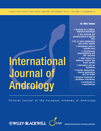Evidence for the involvement of sperm angiotensin converting enzyme in fertilization
Summary
Recently it has been observed that ejaculated human sperm possess high angiotensin converting enzyme (ACE) activity and that this enzyme is released during the process of capacitation. This observation raises the possibility that ACE may be involved in the fertilization process. To verify this hypothesis, we tested the effects of a potent ACE inhibitor, Captopril, on acrosome reaction induced by capacitating medium (3.5% HSA-added BWW) and on ability of human capacitated spermatozoa to penetrate zona-free hamster oocytes.
Addition of Captopril (100 nmol 1--1) modified neither sperm motility nor viability at any time considered, but significantly reduced the acrosome reaction percentages of sperm incubated in capacitating medium. Furthermore, Captopril significantly reduced the percentage of penetrated oocytes. The mean penetration rates both in the absence and presence of Captopril were 65.5 ± 4.9% and 26.9 ± 2.3% (P<0.001) respectively. These findings provide evidence that sperm release of ACE during capacitation may have a physiological role in the regulation of the mechanisms that allow sperm acrosome reaction and thus fertilizability.




